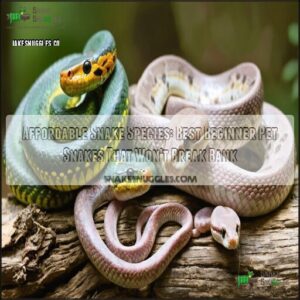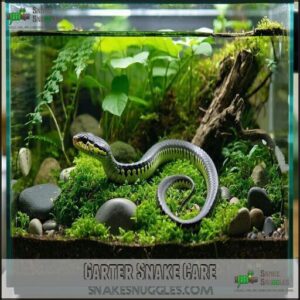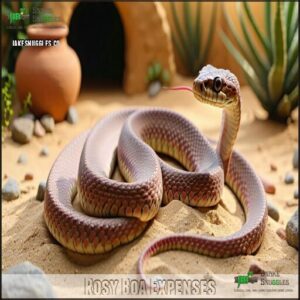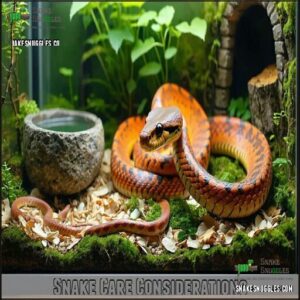This site is supported by our readers. We may earn a commission, at no cost to you, if you purchase through links.

Corn snakes (Pantherophis guttatus) typically cost $30-50 and live 15-20 years. Ball pythons (Python regius) run $50-100 for common morphs and make gentle companions.
Garter snakes (Thamnophis spp.) are often under $40 and eat a varied diet. Rosy boas (Lichanura trivirgata) cost $75-150 but require minimal specialized care.
Milk snakes (Lampropeltis triangulum) stay reasonably priced at $40-80. Each species has unique care requirements that might affect your long-term budget—sometimes the snake with the smallest price tag isn’t actually the most economical option.
Table Of Contents
- Key Takeaways
- Affordable Snake Species
- Low Cost Pet Snakes
- Snake Care Considerations
- Best Snakes for Beginners
- Owning a Pet Snake
- Frequently Asked Questions (FAQs)
- What is the most low maintenance pet snake?
- What are the most cuddly snakes?
- What is the cutest snake to own?
- What snakes are legal as pets?
- Can snakes recognize their owners?
- How often do snakes shed skin?
- What humidity levels do snakes need?
- Are snake allergies common in humans?
- How to introduce snakes to other pets?
- Conclusion
Key Takeaways
- You’ll find several budget-friendly snake species including corn snakes ($30-50), ball pythons ($50-100 for common morphs), garter snakes (under $40), and milk snakes ($40-80) that offer great value for beginners.
- Your initial purchase price isn’t the only expense to consider—proper enclosures (typically $250-300), feeding costs (ranging from $5-20 monthly depending on species), and occasional vet care ($25-186 for checkups) contribute to the total investment.
- You’ll need to match your snake choice with appropriate care requirements—garter snakes need semi-aquatic environments and varied diets, while species like rosy boas require specific temperature gradients and humidity levels.
- You’re making a long-term commitment when purchasing a snake, as lifespans vary considerably—ball pythons live 20-30 years, corn snakes 15-20 years, garter snakes 6-10 years, and rosy boas can reach 25+ years with proper care.
Affordable Snake Species
You don’t have to spend a fortune to own a fascinating pet snake, as there are plenty of affordable options that are beginner-friendly.
Species like the garter snake (Thamnophis sirtalis), milk snake (Lampropeltis triangulum), and corn snake (Pantherophis guttatus) are budget-friendly, easy to care for, and perfect for first-time owners.
Affordable snakes like garters, milk snakes, and corn snakes offer beginner-friendly care without breaking the bank.
Garter Snake Care
Garter snake care is simple and budget-friendly. Start with proper snake enclosure sizing (at least 3x2x2 feet) to guarantee comfort.
These semi-aquatic snakes thrive on a varied garter diet of worms, fish, and pinkies. A suitable habitat requires proper enclosure products for their well-being.
Here are quick tips:
- Handle often for a bond (after brumation periods).
- Watch for shedding issues using water bowls.
- Keep cleanliness a priority.
Milk Snake Ownership
Milk snakes (Lampropeltis triangulum) are affordable snake species with vibrant morphs and easy care needs.
Their temperament variations make them engaging for beginners. With a $60-$150 price tag, they’re known for being active and curious.
Focus on enclosure enrichment, like hides and climbing spots, to keep them happy.
Their diet specifics include small rodents, making feeding manageable and affordable.
Corn Snake Maintenance
When maintaining a corn snake (Pantherophis guttatus), focus on proper snake feeding, handling, and habitat upkeep.
Their friendly temperament makes them beginner-friendly. Choose colorful morphs, as they’re a hit among owners.
Monitor shedding processes and check for common illnesses. Regularly clean enclosures, and avoid overcrowding.
Consider coconut fiber substrate for humidity control. With easy breeding practices and low upkeep, you’ll enjoy their charm without breaking the bank.
Low Cost Pet Snakes
If you’re looking for a pet snake that’s budget-friendly, several species combine affordability with easy care.
Options like Ball Pythons (Python regius) and Rosy Boas (Lichanura trivirgata) offer low upfront costs and long-term value, making them perfect for beginners.
Ball Python Price Range
Why are ball pythons so popular? Their affordability varies with morph costs, python genetics, and breeder reputation.
Wild-type ball pythons start around $20, while unique color variations, like Pied morphs, can reach $500.
Size impact on upkeep is minimal, making them a low-cost pet. Adoption fees offer even cheaper options.
With thousands of options, this snake species affordability makes it great for beginners.
Rosy Boa Expenses
If ball pythons sound pricey, the rosy boa (Lichanura trivirgata) offers affordability with charm.
The initial purchase averages $150, while a $250 enclosure cost sets you up nicely.
With a relaxed feeding schedule—every 5-10 days—food expenses stay manageable.
Known for being friendly and low-stress, these low-cost snakes fit easily into your long-term budget without breaking the bank.
Hognose Snake Costs
Hognose snakes are an affordable snake species, with prices ranging from $60 to $500 depending on the morph costs and rarity.
Their enclosure setup typically runs around $250. Feeding budgets are manageable since these snakes eat small, inexpensive rodents.
Vet expenses are infrequent due to their hardy nature, making their long-term care low-maintenance. Overall, hognose snake costs are beginner-friendly!
Snake Care Considerations
When caring for an affordable pet snake, you’ll need to balance costs with the species’ specific needs.
From choosing the right enclosure to budgeting for food and occasional vet visits, planning ahead keeps your snake healthy and your wallet happy.
Enclosure Requirements
While choosing low-cost snakes, setting up the perfect terrarium matters.
Snake enclosures require specific care to keep your pet thriving. Here’s what to know:
- Terrarium Size: Match the snake breed—larger snakes need extra space.
To guarantee proper care, consider appropriate enclosure dimensions.
- Heating Options: Heat lamps or mats control temperatures.
- Substrate Types: Use aspen, cypress, or paper towels.
- Humidity Control: Some snakes love misty environments!
Feeding Costs Analysis
When you look into the costs of feeding your pet snake, it’s worth breaking down the expenses over time.
Different species have varying dietary needs that substantially impact your monthly budget. Many owners find success when they buy snake food online.
| Snake Species | Monthly Cost | Feeding Frequency | Annual Cost |
|---|---|---|---|
| Garter Snake | $10-15 | Every 2-3 days | $120-180 |
| Corn Snake | $10-20 | Weekly | $120-240 |
| Ball Python | $9-15 | Weekly/Biweekly | $100-180 |
| Milk Snake | $5 | Weekly | $60 |
The table provides a clear overview of the estimated costs for different snake species, including their feeding frequency and annual cost. This information can help you plan and budget accordingly for your pet snake’s needs.
Veterinary Care Expenses
While managing feeding schedules keeps costs predictable, don’t forget about veterinary care expenses.
Snake health checkups typically cost $25-$186, substantially less than for dogs ($50-$250). However, emergency care can quickly add up.
Find exotic veterinarians specializing in reptiles before you need one.
Preventative medicine helps avoid common ailments like respiratory infections or scale rot. Understanding snake parasite prevention is essential for maintaining your pet’s health.
Some insurance options now cover reptiles, potentially saving you from unexpected snake wellbeing costs.
Best Snakes for Beginners
You’ll find species like Pantherophis guttatus (Corn Snake) and Python regius (Ball Python) offer the perfect combination of docile temperament and manageable care requirements for first-time snake owners.
These affordable reptiles won’t strain your budget, with initial purchase prices ranging from $25-$250, plus about $250-$300 for essential supplies that create their comfortable habitat.
The total cost, including the snake and the necessary essential supplies, makes them a great option for those looking to bring a reptile into their home.
African House Snake Facts
Adaptability makes the African House Snake (Boaedon fuliginosus) a perfect companion for novice keepers.
You’ll find these low maintenance snakes reach 30-48 inches, with males staying smaller than females.
Their docile temperament allows for 20-minute handling sessions.
Housing needs include a 30-40 gallon enclosure with proper humidity.
With stable conservation status and varied morph variations available, these affordable beginner snakes can live 15+ years with proper care.
Woma Python Characteristics
With its striking golden-yellow coloration and distinctive dark bands, the Woma Python (Aspidites ramsayi) offers beginners a manageable snake size of 4-5 feet.
You’ll appreciate this Australian native’s docile temperament and food-motivated nature.
They’re more active than most pythons but warm up to handling quickly.
Your Woma’s enclosure needs moderate humidity and a 90°F basking spot to keep this critically endangered species thriving.
Brazilian Rainbow Boa Care
Brazilian Rainbow Boas (Epicrates cenchria) demand much higher humidity levels than our previous Woma Pythons.
You’ll need to maintain 70-90% humidity to keep their iridescent scales healthy and vibrant.
Your snake habitat should include a spacious enclosure (at least 75 gallons for adults) with ample climbing opportunities like branches or PVC poles.
Maintain a basking temperature of 85-90°F at the warm end, with 70-75°F at the cooler side.
Despite their dazzling rainbow appearance, these snake species are surprisingly beginner-friendly, though their specific humidity needs require consistent attention.
Owning a Pet Snake
You’ll discover that owning a pet snake can be both rewarding and economical, with species like Pantherophis guttatus (Corn Snake) and Thamnophis sirtalis (Garter Snake) costing as little as $20-50 to purchase.
Your new reptilian companion will require specific care including proper housing, consistent feeding schedules, and temperature regulation, but won’t demand daily walks or constant attention like traditional pets, making it a low-maintenance option.
Longevity and Life Expectancy
When investing in a pet snake, consider their impressive lifespan commitments.
Snake longevity varies dramatically across species:
- Ball pythons often live 20-30 years with proper care
- Corn snakes typically survive 15-20 years
- Garter snakes have shorter lifespans of 6-10 years
- Rosy boas can reach 25+ years
Environmental factors, genetic predisposition, diet quality, and preventative healthcare all influence snake species lifespans.
Your commitment to quality care directly impacts your reptilian friend’s longevity.
Location and Laws Regulation
Before bringing home a pet snake, you’ll need to check your local snake regulations.
Laws vary substantially across the United States, with non-venomous species generally legal while venomous ones typically require exotic permits.
In Florida, giant snakes must be microchipped, and venomous reptiles need a $100 annual permit.
Georgia enforces strict breeding regulations for native species, with fines reaching $1000 for violations of snake location laws.
Handling and Interaction Tips
Most pet snakes benefit from consistent, gentle handling two to three times weekly.
Always support your snake’s body, avoiding the head area to reduce stress. Watch for signs like hissing or coiling, which indicate your snake needs space.
Corn snakes and ball pythons are particularly docile and friendly snakes for beginners. Remember, each snake has its unique temperament—some enjoy interaction while others prefer admiration from afar.
Prior to handling, it’s important to understand snake body language to prevent bites, and recognize signs that your snake is stressed, allowing for a more enjoyable experience with your pet, and ensuring safe interaction.
Frequently Asked Questions (FAQs)
What is the most low maintenance pet snake?
Gentle as a summer breeze, corn snakes (Pantherophis guttatus) are your lowest maintenance option.
You’ll only need to feed them once weekly, clean monthly, and they’re docile enough for beginners to handle comfortably.
What are the most cuddly snakes?
While snakes aren’t truly "cuddly," Ball Pythons (Python regius) and Corn Snakes (Pantherophis guttatus) are known for their docile temperaments.
They’ll tolerate handling and can drape comfortably across your shoulders during interaction sessions, which showcases their docile nature.
What is the cutest snake to own?
Looking for a scaly supermodel?
You’ll find Ball Pythons (Python regius) irresistibly cute with their puppy-dog eyes and curious head tilts.
They’re docile companions that won’t mind your endless photoshoots and cuddles.
What snakes are legal as pets?
Most states allow corn snakes, ball pythons, king snakes, and milk snakes as pets.
You’ll need to check your local laws, as venomous species and certain constrictors are often restricted or prohibited.
Can snakes recognize their owners?
While not warm and fuzzy like mammals, snakes can recognize your scent and handling patterns.
You’ll notice your snake becoming calmer with regular interaction, showing a basic form of recognition rather than true affection.
How often do snakes shed skin?
You’ll notice your scaly friend shedding its skin every 4-8 weeks, though younger snakes shed more frequently than adults.
The shedding process, called ecdysis, depends on growth rate and environmental conditions.
What humidity levels do snakes need?
Humidity needs vary by snake species.
Desert dwellers like ball pythons require 50-60%, while tropical species need 70-80%.
You’ll want to monitor levels with a hygrometer to prevent respiratory issues or difficult shedding.
Are snake allergies common in humans?
Snake allergies aren’t common in humans. You’re more likely to experience reactions to snake antivenom (25% of cases) than to the snakes themselves. Most pet snake owners never face allergy issues.
How to introduce snakes to other pets?
While your dog barks excitedly, your snake remains silent – this contrast defines their introduction.
Keep sessions short, always supervise, and use separate spaces initially.
You’ll need patience as they gradually acclimate to each other’s presence.
Conclusion
Picture yourself relaxing with your new scaly friend—without emptying your wallet.
When choosing from affordable snake species to own, remember that initial cost is just one factor. You’ll need to take into account enclosure requirements, feeding expenses, and potential vet bills.
Whether you’re drawn to the docile corn snake or the curious garter snake, there’s a perfect serpentine companion waiting for you.
Do your research, prepare properly, and you’ll enjoy years of fascinating reptilian companionship.
- https://www.ingentaconnect.com/contentone/bhs/thj/2011/00000021/00000003/art00005
- https://academic.oup.com/biolinnean/article/77/2/165/2639668
- https://www.rspca.org.uk/documents/1494939/0/Corn+Snake+Care+Sheet+%28PDF+363KB%29.pdf/eab3d86d-0531-0625-5056-ca75887626a8?t=1556101010993
- https://www.mdpi.com/2076-2615/10/11/2116
- https://journals.biologists.com/jeb/article/225/11/jeb244317/275680/Enhanced-short-wavelength-sensitivity-in-the-blue















